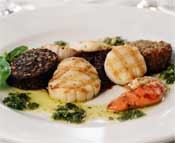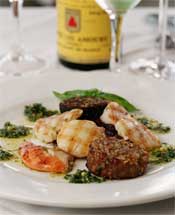Grilled Scallops with Black and White Pudding, Purple Sprouting Broccoli
Something Fishy
 Perched at the far end of Howth harbour, with views across to Ireland’s Eye and over Balscadden Bay (where you may be lucky enough to see a local lobster fisherman raising pots full of treats for your dinner), The King Sitric Fish Restaurant is one of Dublin’s longest established fine dining restaurants, and one of surprisingly few to specialise in seafood.
Perched at the far end of Howth harbour, with views across to Ireland’s Eye and over Balscadden Bay (where you may be lucky enough to see a local lobster fisherman raising pots full of treats for your dinner), The King Sitric Fish Restaurant is one of Dublin’s longest established fine dining restaurants, and one of surprisingly few to specialise in seafood.
They have been awarded the Bord Iascaigh Mhara Seafood Restaurant of the Year title this year, and it s well earned. The menus have changed a little since 1971 (they still have copies, which make fascinating reading) and Howth has changed enormously – except for the Abbey Tavern which, amazingly, has had a restaurant since 1956, The King Sitric was the only restaurant in Howth in those days.
Now it would be hard to keep count. But there were always fish shops on the west pier, and fishing boats in the harbour – and the MacManus philosophy of sourcing the best possible of local produce and telling the customers about them has never changed: informative notes on menu covers state the restaurant’s commitment to local producers, some of whom are named - and gives a listing of Irish fish in six languages.
Ireland needs more restaurants like this, where there is not only a commitment to quality but a clear connection between locally produced food and what you see on your plate; Euro-Toques and Slow Food both champion this philosophy, and both organisations have strong support in Ireland – so let’s see more menus giving credit to the people who raise, grow or catch the food they serve.
And, as you can see from the recipes below (using scallops, which are very good at this time of year), this is not over-complicated cooking. Just the thing for a treat tonight, perhaps?
Grilled Scallops with Black & White Pudding on a bed of Red Onion Marmalade with Pesto
Aidan MacManus uses Shaw’s puddings for this delicious dish, but any good quality black pudding would be fine. This is a verstaile dih which could be used as a starter or main course by varying the portion size and accompaniments. Ingredients for the scallops are given per person (as a generous starter), but there will be enough red onion marmalade and pesto for 4-6 servings:
 2 or 3 scallops
2 or 3 scallops
1 slice each of black & white pudding
A little olive oil
I heaped tablespoon of Red Onion Marmalade (see below)
1 teaspoon pesto (see below)
Red Onion Marmalade:
2 red onions
A little olive oil
Cracked black pepper
2 tablespoons caster sugar
Glass of water
Glass of red wine
Pesto:
4oz/100g basil leaves,
1 teaspoon pine kernels,
4oz/ 100ml Extra Virgin olive oil,
4oz/100g Parmesan cheese, finely grated
First make the Red Onion Marmalade: Slice the onions and saut? in a little oil over a low heat for several minutes. Season with the pepper, add the sugar, water and wine and bring to the boil. Simmer gently for about 20 minutes until it reaches a shiny, jammy consistency.
Next make the Pesto: Blend together all of the listed ingredients, to make a smooth paste. If the consistency is too thick, add a teaspoon of cold water.
To cook the scallops: Heat a ridged grill pan and cook the slices of pudding.
On the same pan, sear the scallops for 1 minute on each side.
To serve: Place the onion in the centre of a warmed serving plate, stack the pudding and the scallops neatly on top and drizzle with the pesto. (Accompany with fresh seasonal vegetables of your choice, if serving as a main course.)
Ingredient of the Week – Purple Sprouting Broccoli

What is it?
A member of the brassica (cabbage) family, sprouting broccoli is closely related to cauliflower and, although there are early and late varieties available, the main season for it is March and April. Purple sprouting broccoli is a very attractive plant, like a big flowering cabbage, and it is the flowering shoots(‘spears’) which are harvested, while still in bud. White and green varieties are also available. Sprouting broccoli is perhaps best described as a ‘country cousin’ of the common imported calabrese found in every supermarket – and so much nicer.
Where Does It Come From?
It is easy to grow in Ireland and Britain, and deserves to be more widely grown - both for its cooking qualities (see below) and because it is a ‘cut and come again’ plant, which grows a new set of edible shoots after the first flush has been harvested. This is very satisfying for the home gardener, who can pop out and cut a few fresh spears for dinner, knowing there will be more to come. The spears must be cut young, before the flowers develop, then the leaves can be eaten like cabbage when the crop of shoots is finished.
Where Can I Get It?
Purple sprouting broccoli is sold in good vegetable shops and farmers markets and some mainstream shops also stock it – it is often available at Marks & Spencer. The best way to ensure a supply is to grow your own – this is a good time to sow the seeds, which are easily available from garden centres.
What Can I do With It?
The great thing about purple sprouting broccoli is that it tastes delicious and is very versatile. The shoots need no preparation – just a little trim at the base end if necessary and a quick rinse under the tap – and they can be steamed or boiled lightly in a little salted water; they lose their purple colour in cooking, turning a beautiful deep green and can be served slightly undercooked like any other leafy green vegetable, as a side dish, or as a main dish such as a warm salad or stir fry. Best of all, perhaps, use the tender young spears in the same way as asparagus - with hollandaise or French dressing, as a starter, for example. Any large leaves can be cooked like cabbage.





There are currently no comments
Leave a comment
Not a member? Register for your free membership now!
Or leave a comment by logging in with: